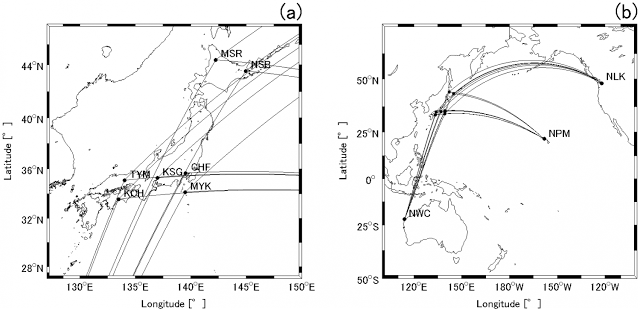
Research at the University of Electro-Communications suggests how to identify anomalies due to geomagnetic storms in low frequency signals, which may help distinguish them from seismic activity.
A potential for earthquake prediction may lie in detecting anomalies in the propagation of very low frequency (VLF: 3-30 kHz) radio signals, as they are greatly affected by ionospheric disturbances that may originate from seismic activity. However there are several other possible causes for VLF anomalies, including terrestrial and space weather, many of which are little understood. In their latest work the UEC researchers help to shed light on how to distinguish VLF anomalies caused by geomagnetic storms that have no relation to seismic activity.
The UEC researchers, Kenshin Tatsuta and Yasuhide Hobara, in collaboration with S. Pal, also associated with the Indian Centre for Space Physics and M. Balikhin at the University of Sheffield in UK, analysed data from 16–21 independent VLF and low-frequency transmitter-receiver paths at different latitudes over 27 months. The transmitter-receiver paths ran at high-latitude (east to west), mid-latitude (east to west) and north to south. They considered statistical parameters including the average signal amplitude and variability of the signal amplitude, and compared changes in the VLF propagation characteristics with data of geomagnetic storm indicators.
The comparisons indicated that VLF propagation is far more likely to exhibit anomalies caused by geomagnetic storms at high latitude than those at mid latitude or north-south transmitter-receiver paths, where anomalies originating from other events are more commonly observed. Paths over land rather than water may be also better for revealing anomalies with seismic origins due to the difference in conductivity.
The UEC team concludes, “Although it is still uncertain that only VLF data can be used to assess the probability of future seismic activities, the characteristics of VLF signals can form a part of the set of parameters that will allow us to provide a warning of possible hazards.”
Ionosphere
The ionosphere is located in the altitude between 60 km and 1000 km above sea level. Here solar radiation can ionize atoms and molecules. The density of atoms and molecules in this region is so low that although the ions and electrons created attract each other, they may still not readily recombine, giving rise to an ionic plasma.
Ionisation in the ionosphere is affected by solar intensity which varies over the course of the day and changes in seasons. As a result the composition of the ionosphere will vary diurnally and seasonally. It is also affected by space events, such as solar flares and geomagnetic storms, the Earth’s atmospheric weather such as thunderstorms, as well as seismic events.
Electromagnetic waves, such as from radio transmitters, interact with the ionosphere which affects the propagation characteristics, particularly electromagnetic signals at very low frequencies. How propagation is affected depends on the conductivity changes of the ionosphere along the propagation path. The challenge is distinguishing the signature of the different events that perturb the ionosphere in VLF signals to identify the cause.
Geomagnetic storms
The region in which the Earth’s magnetic field affects the paths of charged objects is described as the magnetosphere. Further away and the charged object may be more affected by the magnetic fields from other astronomical objects.
The electrically conducting plasma inside the Sun – solar wind – gives rise to its own magnetic field. A shock wave in solar wind can interact with the magnetosphere, initially compressing it and increasing its energy. This can increase electric field lines in the magnetosphere and electric currents in the magnetosphere and ionosphere.
Both the auroral electrojet and disturbance storm time indices are indicators of geomagnetic storms. The authors used measurements for both over the same time period to compare with the VLF propagation data.
The statistical parameters used
The daily average amplitude of the VLF transmitter signals used in this study was calculated by the average nighttime amplitude at a defined day. The residual so-called ‘trend’ at a defined day was then derived by the difference between the average nighttime amplitude at the defined day and the average amplitude over the previous 15 days .
The researchers specifically looked at the trend as well as the dispersion defined as the standard deviation of the residual each day and the nighttime fluctuation defined by the residual integrated over the whole night. These three statistical parameters considered may differ from study to study due to the different origins of perturbations and geographical configuration of the propagation paths, and the researchers will further study the effect of the VLF anomalies from different natural origins for comparison.
Reference:
K. Tatsuta et al. Sub-ionospheric VLF signal anomaly due to geomagnetic storms: a statistical study, Annales Geophysicae (2015). DOI: 10.5194/angeo-33-1457-2015
Note: The above post is reprinted from materials provided by University of Electro-Communications.










